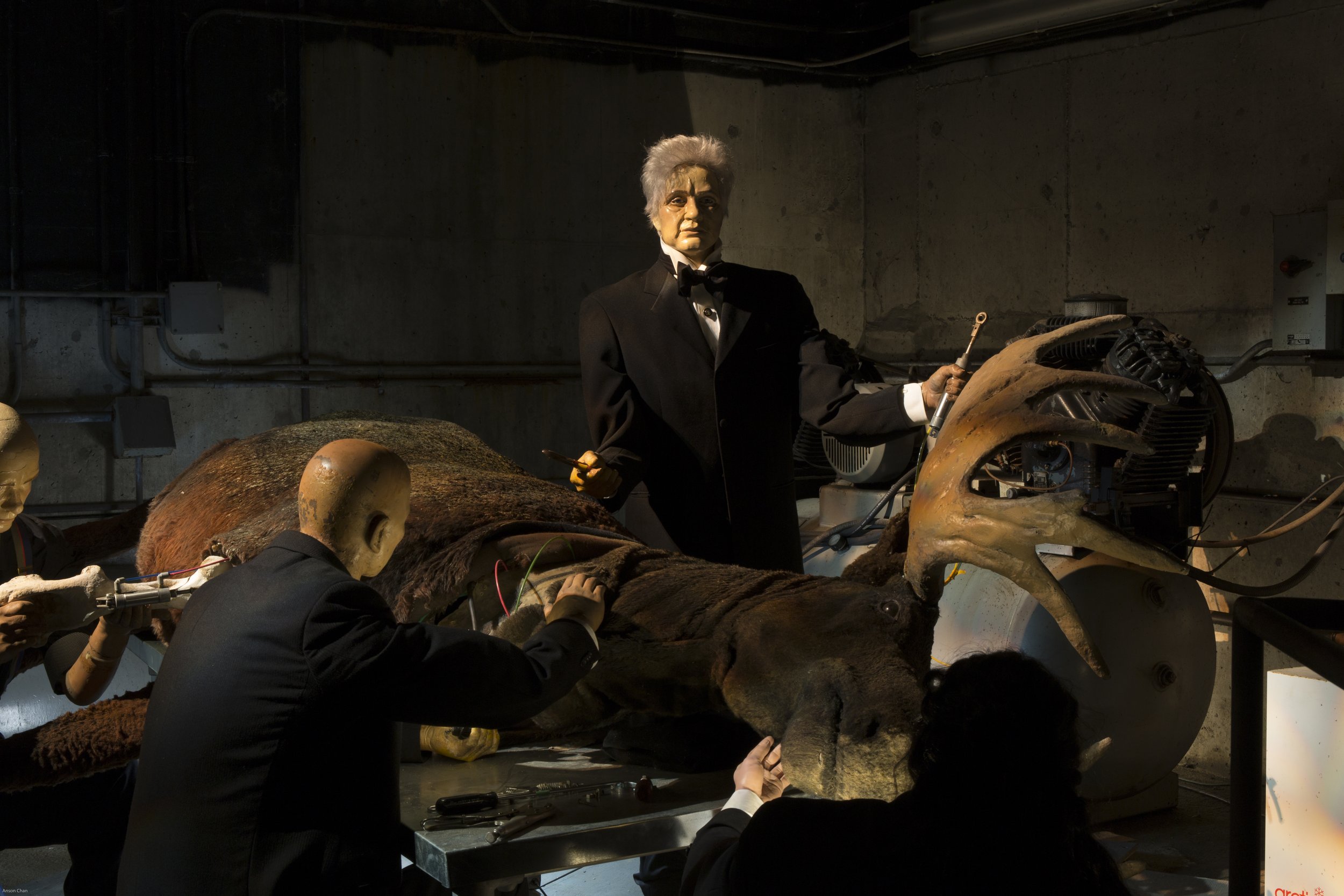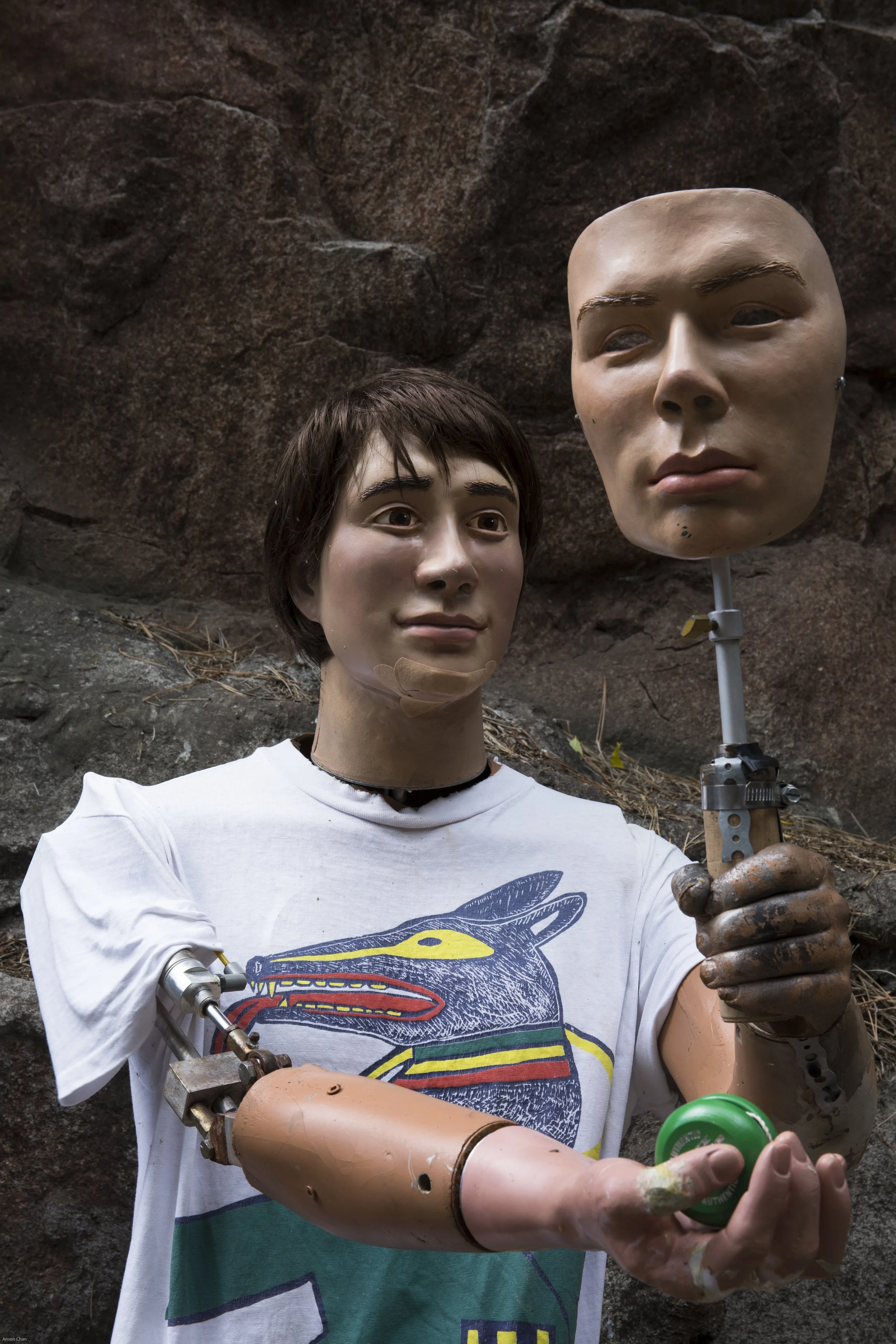Still - (Mountain) - 2016
Installation
Dimensions: 16’ x 140” x 30’
Animatronic figures from the Wilderness Adventure Ride, wood, metal, tools, clothing
Destroyed
This large installation in and around the mountain which housed the Wilderness Adventure Ride at Ontario Place consisted of 3 tableaus. As you walked down the river gorge and before you entered the mountain you were met by the Boy and the Bear. Once inside the mountain you met the Greeter who shared this anti chamber with the four Moosemen pulling a gurney. The gurney supported a cow moose who had incurred a neck injury. As you proceeded deeper into the mountain you came upon what appears to be a makeshift surgical operating room. A series of characters are operating on a bull moose, replacing a pneumatic cylinder in his front right leg. Centered in this group of medical practitioners is a standing figure who we take to be the lead surgeon. The principle tableau is based on the 1875 painting the Gross Clinic by Thomas Eakins. As you turned away to return, tucked in an alcove was Thomas Eakins.
What was striking about the figures as I found them was the detail and care which had been taken in their fabrication and presentation. Visitors would only see these figures and animals for a second as they cascaded down the water slough. The faces had all been sculpted and there were many custom hands. Using mannequin heads and hands as a starting point someone had made them as realistic as possible.
There was no history of how the ride had been conceived, planned and fabricated.
About a week before the In/Future exhibition was to open I received a letter from Peter Sloan. He was one of the initial sculptors of the Wilderness Adventure Ride and with his permission I am including his description of that process.
“In 1985 my partner and I fabricated all the sculptures for the wilderness adventure ride. Chairman Mills got the contract to supply Ontario place with the display and sub-contacted my partner, Colleen Slasor, and I, to build them. We build them at their facility way up in Willowdale and Colleen’s studio, and lastly on site, over a period of about 6 months. John Akman was hired to do the pneumatic articulations. Last I heard, which was long ago, John was in Orlando working for the Disney corporation and sadly, Colleen passed away a year or two ago.
These robotic sculptures were meant to be seen briefly as the audience whipped by in the “log” boats as they went down the lumber chute. For the human figures we took manikins and tweaked them as best we could to look natural from a distance and worked within the constraints of the robotic hardware John would create for us to install. Every logger and miner has my hands, in urethane rubber, painfully made from dipping my iced up hands in hot wax to make the moulds. It was just as painful keeping my vasolined hands in the bucket of watery ice cubes for as long as could stand it, as it was to plunge them into the hot wax, let alone the hairs being ripped out off my wrist were I missed shaving to avoid that very thing. We had trouble with some of the batches of rubber which caused discolouration and drooping. We used glass eyes inserted and glued from the inside and real wigs. We did our best to make them as real looking as we could, within our limited budget.
The animals were formed using taxidermy blanks and then re-enforced with fibreglass. I think we fabricated the antlers of the moose or perhaps made a mould of real ones. They were filed with expanding isofoam. They had to be light so the robotics would work as smoothly as we could make them. The fur was all from fake fur we bought in bolts from textile suppliers on Spadina. Patterns were made from cheap cloth and then we pinned and cut out the shapes and then struggling for a good fit, glued, them on with contact cement. It was a challenging job we carried out both on site and at Colleen’s studio at 44 Dovercourt, back then an old warehouse with a slum lord and relatively cheap rent. I lived on the floor of her studio for a while before I found a better place. Heady days. I ended up back there sharing a studio with Tom Hodgson.
Every spring for many years Colleen and I got the contract from Ontario Place to spruce up the sculptures for the next season and received quite a few spin off jobs as well. One consisting of spraying the faded fake rocks with fresh paint to make it look like northern Ontario granite. We devised a system that worked well for this using back pack weed sprayers and splattered it just so. As hokey and faux as all this was, we were proud of the work we did and learned good skills doing it. The weather was hard on these things and I can’t imagine the shape you found them in when they were mothballed. I think they were neglected for a while.”
Images provided by Peter Sloan












